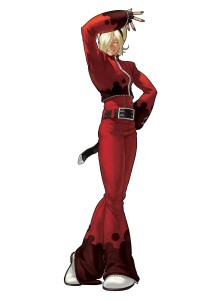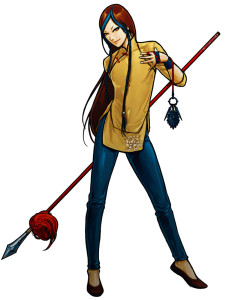Gender and Home
by RadiumEyes, HSM guest contributor
To open this article, let’s go back to the Victorian period. Francis Galton, cousin of Charles Darwin, created a series of composite photographs in his study of the “composite portraiture.” Each image he made ostensibly identified a particular profession, illness victim and other traits. For example, he had a series of such photographs proclaiming to identify the “prevalent types of features” common among men who commit “larceny (without violence).” This method of typological photography is misleading, as it inherently assumes morphological traits exclusive to certain groups of people; that Galton made composites underscores this fact.
This approach to codifying identity isn’t new, and it certainly isn’t the only place you find people trying to classify groups of people on rather spurious criteria. Gender identity is one of the biggest examples of this, if not the biggest; defining “masculine” and “feminine,” “male” and “female” remains a cornerstone of civilization. The United States alone has numerous examples of this phenomenon – masculinity typically carries the connotation of the breadwinner, warrior and businessman for many people, while femininity implies fragility, beauty and homebody. You don’t need to look that far back to see this attitude in action – television shows like I Love Lucy and The Rifleman reinforced social mores, making a clear separation between the “male” and “female” spheres. TV Westerns in the ‘50s and ‘60s usually featured a patriarchal cowboy/sheriff/marshal and women who usually didn’t get involved in the gunfights.
Today, it’s still a bit of a struggle to have strong female leads, and this is certainly true of video games. The “damsel in distress” motif reared its head in the Mario franchise, and Princess Peach’s early years saw her at the mercy of a reptilian kidnapper. Modern first-person shooters feature the “rugged, jaded male soldier” archetype; the Call of Duty franchise in particular revels in this masculinized presentation of warfare. Games like Red Faction 2 and Half-Life 2 had prominent female characters, but the action focused squarely on the PC, invariably male.
However, characters like Lara Croft and Samus Aran challenged that convention; men didn’t have to dominate the action-adventure genre, and the two mentioned became quite successful (even if the respective studios did rely on sex appeal in large measure.) Despite the reliance on sexual allure for female characters, they’re making strides in genres they originally didn’t make a dent in. And this isn’t the only trend we can see – games such as the King of Fighters series also include androgynous characters. Even the Final Fantasy series had an example of this, with Kuja from FFIX.
 So, where do we go from here? Gender identity still exists as a peculiar institution; how we define “masculinity” and “femininity” is still informed partially by generations-old perceptions. This happens not only in the United States, but in other countries as well – Japan had a strict social hierarchy during the Edo period (1600/1611-1868) that carefully defined the roles men and women could enter. Men could hold power as daimyo, and the Tokugawa shogunate passed to male heirs. Women, however, varied in power depending on social strata – those in samurai families had to submit to male household leaders (although they could attain power themselves), while those in lower classes had few social expectations placed upon them.
So, where do we go from here? Gender identity still exists as a peculiar institution; how we define “masculinity” and “femininity” is still informed partially by generations-old perceptions. This happens not only in the United States, but in other countries as well – Japan had a strict social hierarchy during the Edo period (1600/1611-1868) that carefully defined the roles men and women could enter. Men could hold power as daimyo, and the Tokugawa shogunate passed to male heirs. Women, however, varied in power depending on social strata – those in samurai families had to submit to male household leaders (although they could attain power themselves), while those in lower classes had few social expectations placed upon them.
As far as the modern day is concerned, gender identity has some hurdles, many holdovers from an earlier time. For me, this is a somewhat personal article, as I thought about my own gender identity for some time. To be perfectly honest, I’ve been influenced by anime to do some soul-searching; anime showed me that someone’s gender is quite mutable, and one isn’t restricted to biological determinants. To be honest, I’ve had numerous psychological issues over the years, and my constant exposure to anime influenced this soul-searching in me. With a few things acting in concert, thoughts of gender identity got internalized to the point where I spent a few years wondering about my body and what would make me comfortable. Obsessing over these things resulted in my recent delving into this topic, with me wondering about what it would be like to be feminine. But therein lies the issue. Is there even a dividing line between male and female, socially speaking? Can we really speak of a clearly-defined “masculine” or “feminine” set of behavioral traits? Serious questions like that aren’t easy to answer. However, this does lead into the important issue of gender identity on Home.
In Home, you have distinct clothing lines for male and female avatars (although things like earrings are unisex.) The benefit of Home is that you can choose gender at will, meaning people who feel more comfortable with the opposite gender could select that and forge ahead creating their identity. However, what if you wish to wear clothing specifically made for one gender when you’re the other gender?
 There’s nothing physically restricting people in real life from doing this; social expectations, however, do have a say in this, although we’re living in a time where the unstated social proscriptions against this sort of thing are fading. A true sense of fashion equality would thus still take time to occur, as society as a whole would have to adjust to a new frontier of clothing designs for both genders. For the longest time, clothing types and styles were dictated by the social tide – men wore their best suits and ties, for example, to formal functions, and they certainly didn’t wear elaborate dresses.
There’s nothing physically restricting people in real life from doing this; social expectations, however, do have a say in this, although we’re living in a time where the unstated social proscriptions against this sort of thing are fading. A true sense of fashion equality would thus still take time to occur, as society as a whole would have to adjust to a new frontier of clothing designs for both genders. For the longest time, clothing types and styles were dictated by the social tide – men wore their best suits and ties, for example, to formal functions, and they certainly didn’t wear elaborate dresses.
However, this is purely social in scope, and there’s a stigma attached to wishing to wear certain clothes that people perceive as “outside your gender.” Home may have the same notions, but it doesn’t have to – you have more of a liberty to decide how you present yourself online, and that includes your choice in dress. If certain lines appeal to you, you’re free to purchase clothes from that line and wear them. What makes Home restrictive in this matter, though, is (as mentioned above) the gender-defined perspective of clothing – women have their own specific set, as do men, and it reinforces the old “masculine-feminine” dichotomy that lies at its heart.
This would be a great way of testing the waters; release a few clothes that both men and women can wear, that aren’t common gender-neutral fare such as T-shirts, sneakers and jeans. Show the Home world that clothes, like the avatars that wear them, aren’t obligated to choose a gender, and clothes do not have to be presented as “masculine” or “feminine” in tone.
Would people buy these? That’s a good question. But we’ll never really know until we have the chance to choose true unisex clothing.
Share
| Tweet |



 Twitter
Twitter
Really interresting idea. Of course there is way too much here to cover in a short reply. So I will stick to the basic mechanics.
From a marketing viewpoint it might require a lot of works for very few sales. Althou I’m pretty sure a significant number of users would be interrested in it. The other thing that might scare a dev from doing this is the predectable opinion backlash. We all know the proverbial few shoutings covering the silent majority.
Should it stop them from doing it? “Ethically” no. But their accountant might think otherwise.
Great article. Loved it. *hit share*
I’d be all for it if it meant I wouldn’t be stuck with the tacky style and fit so much “clothing for females” has. I’d also like to see female avatars able to hold their heads straight instead of the bent head, “just make me a victim,” design for them when standing…although, this may be because I tend to mix attributes in my avatars. Perhaps it’s intended to be a cultural trait. I still find it offensive.
Forget the clothes, how about some ‘muscular bodies’ for the ladies! After all, virtual push-ups must count for something!